Rei Kawakami
Anomaly Object Segmentation with Vision-Language Models for Steel Scrap Recycling
Jun 16, 2025Abstract:Recycling steel scrap can reduce carbon dioxide (CO2) emissions from the steel industry. However, a significant challenge in steel scrap recycling is the inclusion of impurities other than steel. To address this issue, we propose vision-language-model-based anomaly detection where a model is finetuned in a supervised manner, enabling it to handle niche objects effectively. This model enables automated detection of anomalies at a fine-grained level within steel scrap. Specifically, we finetune the image encoder, equipped with multi-scale mechanism and text prompts aligned with both normal and anomaly images. The finetuning process trains these modules using a multiclass classification as the supervision.
Zero-Shot Peg Insertion: Identifying Mating Holes and Estimating SE(2) Poses with Vision-Language Models
Mar 08, 2025Abstract:Achieving zero-shot peg insertion, where inserting an arbitrary peg into an unseen hole without task-specific training, remains a fundamental challenge in robotics. This task demands a highly generalizable perception system capable of detecting potential holes, selecting the correct mating hole from multiple candidates, estimating its precise pose, and executing insertion despite uncertainties. While learning-based methods have been applied to peg insertion, they often fail to generalize beyond the specific peg-hole pairs encountered during training. Recent advancements in Vision-Language Models (VLMs) offer a promising alternative, leveraging large-scale datasets to enable robust generalization across diverse tasks. Inspired by their success, we introduce a novel zero-shot peg insertion framework that utilizes a VLM to identify mating holes and estimate their poses without prior knowledge of their geometry. Extensive experiments demonstrate that our method achieves 90.2% accuracy, significantly outperforming baselines in identifying the correct mating hole across a wide range of previously unseen peg-hole pairs, including 3D-printed objects, toy puzzles, and industrial connectors. Furthermore, we validate the effectiveness of our approach in a real-world connector insertion task on a backpanel of a PC, where our system successfully detects holes, identifies the correct mating hole, estimates its pose, and completes the insertion with a success rate of 88.3%. These results highlight the potential of VLM-driven zero-shot reasoning for enabling robust and generalizable robotic assembly.
Rectified Lagrangian for Out-of-Distribution Detection in Modern Hopfield Networks
Feb 19, 2025Abstract:Modern Hopfield networks (MHNs) have recently gained significant attention in the field of artificial intelligence because they can store and retrieve a large set of patterns with an exponentially large memory capacity. A MHN is generally a dynamical system defined with Lagrangians of memory and feature neurons, where memories associated with in-distribution (ID) samples are represented by attractors in the feature space. One major problem in existing MHNs lies in managing out-of-distribution (OOD) samples because it was originally assumed that all samples are ID samples. To address this, we propose the rectified Lagrangian (RegLag), a new Lagrangian for memory neurons that explicitly incorporates an attractor for OOD samples in the dynamical system of MHNs. RecLag creates a trivial point attractor for any interaction matrix, enabling OOD detection by identifying samples that fall into this attractor as OOD. The interaction matrix is optimized so that the probability densities can be estimated to identify ID/OOD. We demonstrate the effectiveness of RecLag-based MHNs compared to energy-based OOD detection methods, including those using state-of-the-art Hopfield energies, across nine image datasets.
Multi-Point Positional Insertion Tuning for Small Object Detection
Dec 24, 2024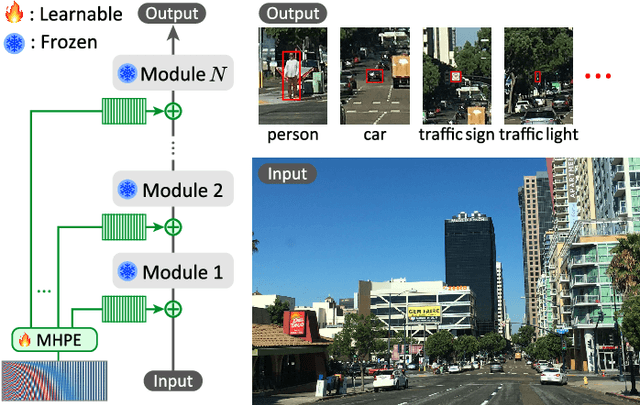
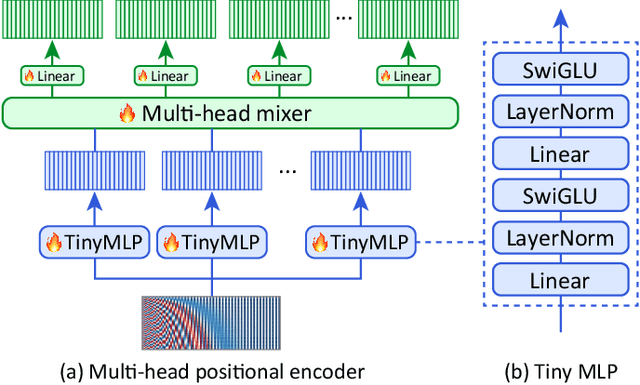
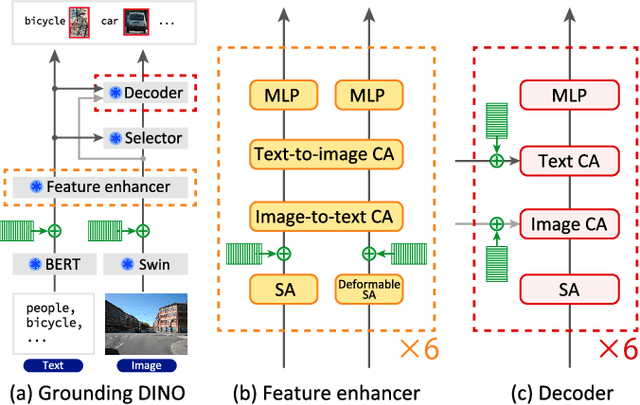
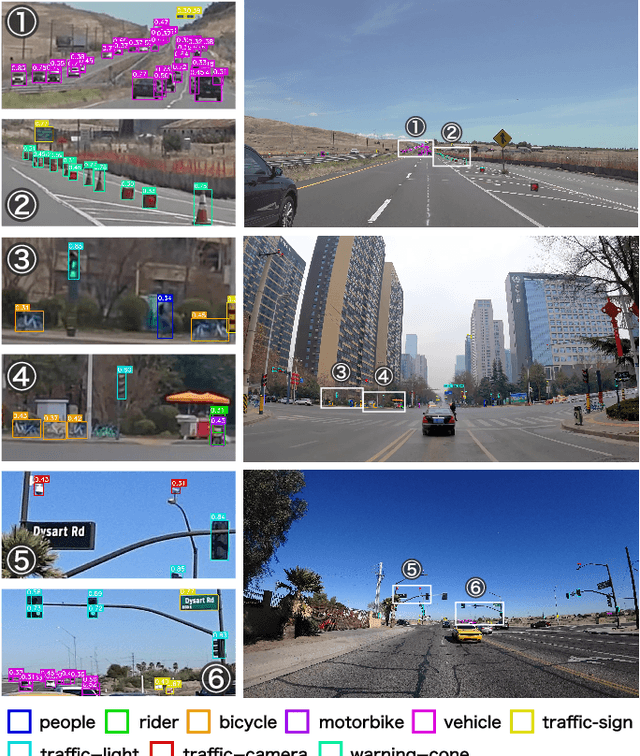
Abstract:Small object detection aims to localize and classify small objects within images. With recent advances in large-scale vision-language pretraining, finetuning pretrained object detection models has emerged as a promising approach. However, finetuning large models is computationally and memory expensive. To address this issue, this paper introduces multi-point positional insertion (MPI) tuning, a parameter-efficient finetuning (PEFT) method for small object detection. Specifically, MPI incorporates multiple positional embeddings into a frozen pretrained model, enabling the efficient detection of small objects by providing precise positional information to latent features. Through experiments, we demonstrated the effectiveness of the proposed method on the SODA-D dataset. MPI performed comparably to conventional PEFT methods, including CoOp and VPT, while significantly reducing the number of parameters that need to be tuned.
GUMBEL-NERF: Representing Unseen Objects as Part-Compositional Neural Radiance Fields
Oct 27, 2024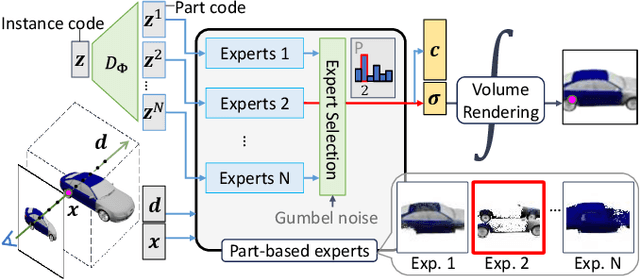
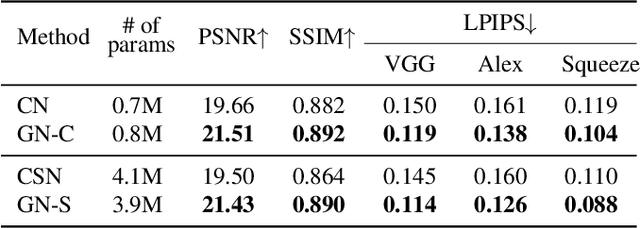

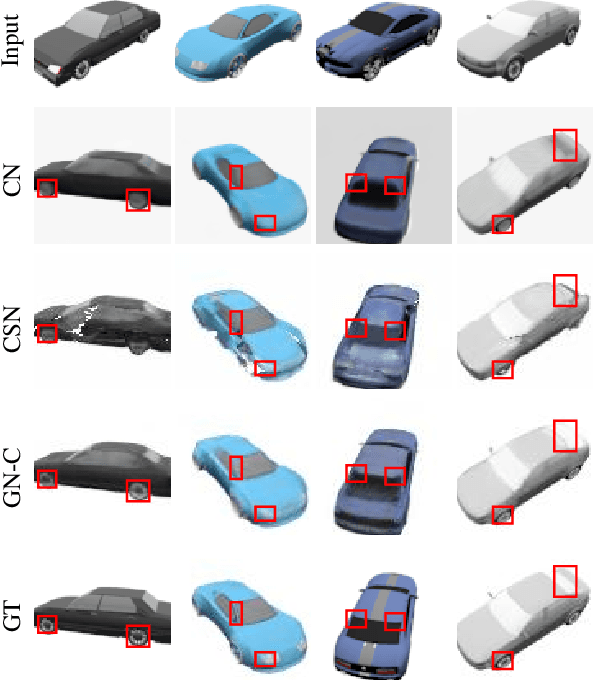
Abstract:We propose Gumbel-NeRF, a mixture-of-expert (MoE) neural radiance fields (NeRF) model with a hindsight expert selection mechanism for synthesizing novel views of unseen objects. Previous studies have shown that the MoE structure provides high-quality representations of a given large-scale scene consisting of many objects. However, we observe that such a MoE NeRF model often produces low-quality representations in the vicinity of experts' boundaries when applied to the task of novel view synthesis of an unseen object from one/few-shot input. We find that this deterioration is primarily caused by the foresight expert selection mechanism, which may leave an unnatural discontinuity in the object shape near the experts' boundaries. Gumbel-NeRF adopts a hindsight expert selection mechanism, which guarantees continuity in the density field even near the experts' boundaries. Experiments using the SRN cars dataset demonstrate the superiority of Gumbel-NeRF over the baselines in terms of various image quality metrics.
ELP-Adapters: Parameter Efficient Adapter Tuning for Various Speech Processing Tasks
Jul 28, 2024Abstract:Self-supervised learning has emerged as a key approach for learning generic representations from speech data. Despite promising results in downstream tasks such as speech recognition, speaker verification, and emotion recognition, a significant number of parameters is required, which makes fine-tuning for each task memory-inefficient. To address this limitation, we introduce ELP-adapter tuning, a novel method for parameter-efficient fine-tuning using three types of adapter, namely encoder adapters (E-adapters), layer adapters (L-adapters), and a prompt adapter (P-adapter). The E-adapters are integrated into transformer-based encoder layers and help to learn fine-grained speech representations that are effective for speech recognition. The L-adapters create paths from each encoder layer to the downstream head and help to extract non-linguistic features from lower encoder layers that are effective for speaker verification and emotion recognition. The P-adapter appends pseudo features to CNN features to further improve effectiveness and efficiency. With these adapters, models can be quickly adapted to various speech processing tasks. Our evaluation across four downstream tasks using five backbone models demonstrated the effectiveness of the proposed method. With the WavLM backbone, its performance was comparable to or better than that of full fine-tuning on all tasks while requiring 90% fewer learnable parameters.
Fixed-Weight Difference Target Propagation
Dec 19, 2022



Abstract:Target Propagation (TP) is a biologically more plausible algorithm than the error backpropagation (BP) to train deep networks, and improving practicality of TP is an open issue. TP methods require the feedforward and feedback networks to form layer-wise autoencoders for propagating the target values generated at the output layer. However, this causes certain drawbacks; e.g., careful hyperparameter tuning is required to synchronize the feedforward and feedback training, and frequent updates of the feedback path are usually required than that of the feedforward path. Learning of the feedforward and feedback networks is sufficient to make TP methods capable of training, but is having these layer-wise autoencoders a necessary condition for TP to work? We answer this question by presenting Fixed-Weight Difference Target Propagation (FW-DTP) that keeps the feedback weights constant during training. We confirmed that this simple method, which naturally resolves the abovementioned problems of TP, can still deliver informative target values to hidden layers for a given task; indeed, FW-DTP consistently achieves higher test performance than a baseline, the Difference Target Propagation (DTP), on four classification datasets. We also present a novel propagation architecture that explains the exact form of the feedback function of DTP to analyze FW-DTP.
Parameter Efficient Transfer Learning for Various Speech Processing Tasks
Dec 06, 2022Abstract:Fine-tuning of self-supervised models is a powerful transfer learning method in a variety of fields, including speech processing, since it can utilize generic feature representations obtained from large amounts of unlabeled data. Fine-tuning, however, requires a new parameter set for each downstream task, which is parameter inefficient. Adapter architecture is proposed to partially solve this issue by inserting lightweight learnable modules into a frozen pre-trained model. However, existing adapter architectures fail to adaptively leverage low- to high-level features stored in different layers, which is necessary for solving various kinds of speech processing tasks. Thus, we propose a new adapter architecture to acquire feature representations more flexibly for various speech tasks. In experiments, we applied this adapter to WavLM on four speech tasks. It performed on par or better than naive fine-tuning, with only 11% of learnable parameters. It also outperformed an existing adapter architecture.
Informative Sample-Aware Proxy for Deep Metric Learning
Nov 18, 2022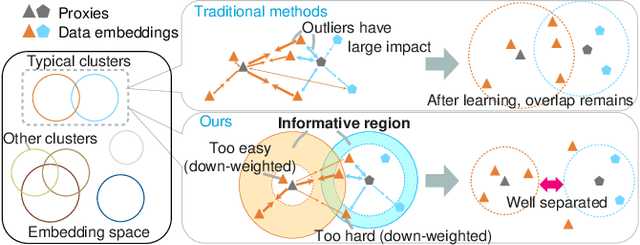
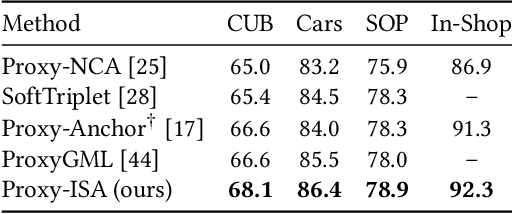
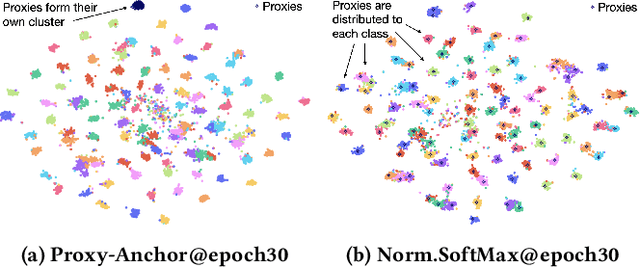
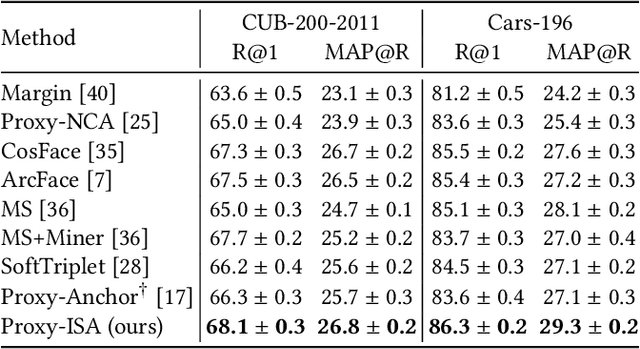
Abstract:Among various supervised deep metric learning methods proxy-based approaches have achieved high retrieval accuracies. Proxies, which are class-representative points in an embedding space, receive updates based on proxy-sample similarities in a similar manner to sample representations. In existing methods, a relatively small number of samples can produce large gradient magnitudes (ie, hard samples), and a relatively large number of samples can produce small gradient magnitudes (ie, easy samples); these can play a major part in updates. Assuming that acquiring too much sensitivity to such extreme sets of samples would deteriorate the generalizability of a method, we propose a novel proxy-based method called Informative Sample-Aware Proxy (Proxy-ISA), which directly modifies a gradient weighting factor for each sample using a scheduled threshold function, so that the model is more sensitive to the informative samples. Extensive experiments on the CUB-200-2011, Cars-196, Stanford Online Products and In-shop Clothes Retrieval datasets demonstrate the superiority of Proxy-ISA compared with the state-of-the-art methods.
PoF: Post-Training of Feature Extractor for Improving Generalization
Jul 05, 2022



Abstract:It has been intensively investigated that the local shape, especially flatness, of the loss landscape near a minimum plays an important role for generalization of deep models. We developed a training algorithm called PoF: Post-Training of Feature Extractor that updates the feature extractor part of an already-trained deep model to search a flatter minimum. The characteristics are two-fold: 1) Feature extractor is trained under parameter perturbations in the higher-layer parameter space, based on observations that suggest flattening higher-layer parameter space, and 2) the perturbation range is determined in a data-driven manner aiming to reduce a part of test loss caused by the positive loss curvature. We provide a theoretical analysis that shows the proposed algorithm implicitly reduces the target Hessian components as well as the loss. Experimental results show that PoF improved model performance against baseline methods on both CIFAR-10 and CIFAR-100 datasets for only 10-epoch post-training, and on SVHN dataset for 50-epoch post-training. Source code is available at: \url{https://github.com/DensoITLab/PoF-v1
 Add to Chrome
Add to Chrome Add to Firefox
Add to Firefox Add to Edge
Add to Edge